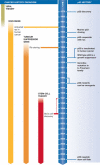The history of p53. A perfect example of the drawbacks of scientific paradigms
- PMID: 20930848
- PMCID: PMC2966958
- DOI: 10.1038/embor.2010.159
The history of p53. A perfect example of the drawbacks of scientific paradigms
Abstract
The history of p53 and the various interpretations of its function in cells serves as an example of how scientific paradigms can influence research fields. It also offers some interesting lessons for young scientists in search of a rewarding research topic.
Conflict of interest statement
The author declares that he has no conflict of interest.
Figures
References
-
- Baker SJ et al. (1989) Chromosome 17 deletions and p53 gene mutations in colorectal carcinomas. Science 244: 217–221 - PubMed
-
- Cairns J (1981) The origin of human cancers. Nature 289: 353–357 - PubMed
-
- Caron de Fromentel C, Viron A, Puvion E, May P (1986) SV40 large T-antigen and transformation related protein p53 are associated in situ with nuclear RNP structures containing hnRNA of transformed cells. Exp Cell Res 164: 35–48 - PubMed
Publication types
MeSH terms
Substances
LinkOut - more resources
Full Text Sources
Research Materials
Miscellaneous



